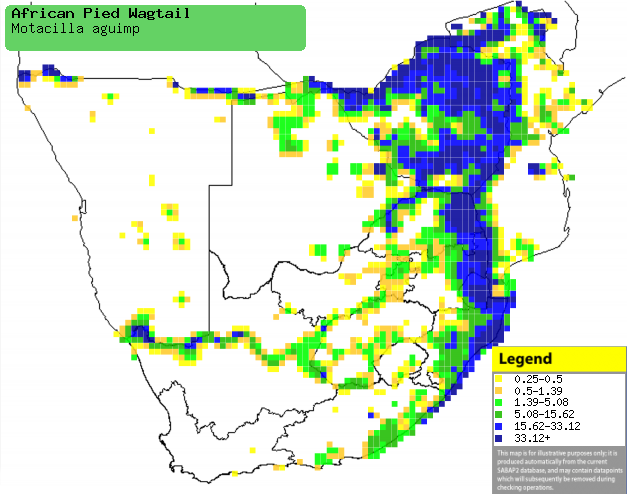|
Motacilla aguimp (African pied
wagtail)
Bontkwikkie [Afrikaans]; Umcelu, Umvemve, Umventshana
(generic terms for wagtail) [Xhosa]; umVemve (generic term for wagtail)
[Zulu]; Kamukombo (generic term for wagtails) [Kwangali]; Motjoli (generic
term for wagtails) [South Sotho]; Umvemve [Swazi]; Afrikaanse bonte
kwikstaart [Dutch]; Bergeronnette pie [French]; Witwenstelze [German];
Alvéola-preta-e-branca [Portuguese]
Life
> Eukaryotes >
Opisthokonta
> Metazoa (animals) >
Bilateria >
Deuterostomia > Chordata >
Craniata > Vertebrata (vertebrates) > Gnathostomata (jawed
vertebrates) > Teleostomi (teleost fish) > Osteichthyes (bony fish) > Class:
Sarcopterygii (lobe-finned
fish) > Stegocephalia (terrestrial
vertebrates) > Tetrapoda
(four-legged vertebrates) > Reptiliomorpha > Amniota >
Reptilia (reptiles) >
Romeriida > Diapsida > Archosauromorpha > Archosauria >
Dinosauria
(dinosaurs) > Saurischia > Theropoda (bipedal predatory dinosaurs) >
Coelurosauria > Maniraptora > Aves
(birds) > Order: Passeriformes
> Family: Motacillidae > Genus: Motacilla
Distribution and habitat
Occurs across much of sub-Saharan Africa, from Senegal to
Sudan south to southern Africa. Here it is fairly common in Zimbabwe,
Mozambique, eastern and north-western South Africa and northern Namibia,
while more scarce in Botswana and the interior of South Africa. It generally
prefers wide rivers and other water bodies with sandy banks or scattered
boulders, but it may also occupy rocky coastlines. It is also common in man-made
habitats, such as parks, playing fields, golf courses, suburban gardens and
sewage works.
|
 |
|
Distribution of African pied wagtail in southern Africa,
based on statistical smoothing of the records from first SA Bird Atlas
Project (©
Animal Demography unit, University of
Cape Town; smoothing by Birgit Erni and Francesca Little). Colours range
from dark blue (most common) through to yellow (least common).
See here for the latest distribution
from the SABAP2. |
Predators and parasites
Chicks have been recorded as prey of
Centropus
burchellii (Burchell's coucal).
Food
It mainly eats insects, especially flies but also other
invertebrates, grass seeds, tadpoles, small fish and scraps of human food. The following food items have been recorded
in its diet:
- Invertebrates
- insects
- small crabs
- worms
- Other
- tadpoles
- small fish
- human food scraps
Breeding
- Monogamous, territorial solitary nester, chasing intruders out of its
territory and often attacking its reflection in car mirrors. Breeding pairs
rear multiple broods in each breeding season, usually up to three per season
in southern Africa, although in Kenya it can bring up seven.
- The nest is built by both sexes, consisting of a deep cup of dry grass,
weeds, roots, stems, leaves, downy seeds, flood debris, string and other
coarse materials; the interior is lined with rootlets, fine grass, hair and
feathers. It is typically placed close to water on the ground or in
vegetation, such as reeds, grass and flood debris. Man-made sites are
commonly used as well, especially outbuildings, holes in walls, building
ledges, bridges, roofs and boats, continuing to care for its brood even if
the ship goes out to sea for 9 hours a day.
- Egg-laying season is almost year-round, peaking twice from
August-November as well as from February-April.
- It lays 2-5 eggs, which are usually incubated by both sexes for about
12-15 days.
- The chicks are fed by both sexes on a diet of insects, leaving the nest
after about 15-18 days. They remain dependent on their parents for food for
about two more weeks, about 3-6 days later they are chased out of the
territory so that the adults can rear another brood.
Threats
Not threatened, in fact it is closely associated with
humans and has benefited from the construction of dams.
References
-
Hockey PAR, Dean WRJ and Ryan PG 2005. Roberts
- Birds of southern Africa, VIIth ed. The Trustees of the John Voelcker
Bird Book Fund, Cape Town.
|
